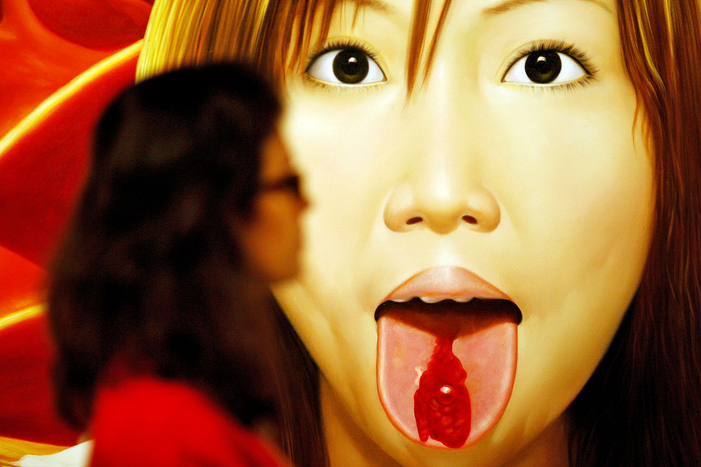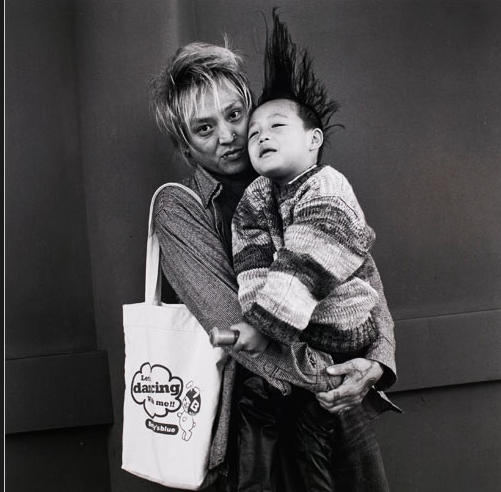Public life involves seeing the faces of strangers. Often they are but a blur, yet they can create a unique emotional experience. Ezra Pound captured that experience in his famous poem, “In a Station of the Metro”:
The apparition of these faces in the crowd/Petals on a wet, black bough.
The faces are of individuals yet unknown save as part of an unconscious pattern; ghostlike in their sense of social presence and yet vividly present in aesthetic space; beautiful yet ephemeral. Pound was able to create this masterpiece of emotional discernment and poetic compression by imitating Japanese haiku. One wonders what he would have thought of this face:
Actually, there are two faces, neither one quite what Pound depicted. The large image is a work of art by Kaho Nakmura on display at the Tokyo Express exhibition in London. The woman in the foreground, a dark smudge on a bright background, is someone walking through the gallery. Though seeming opposites–large/small, bright/dark, art/life–the two women are tied together by the photographic composition and the color red. The reversal of foreground and background makes each a commentary on the other. Thus, the red of her coat is exposed by the bloody glob on that tongue. In actual display, what should be inside the body is imitated on the surface, while what would seem to be on the surface–our expressiveness–is in fact hidden behind a mask, say, the flat expression and dark glasses of the onlooker.
So it is that the artwork is transgressive. This young woman is so out there, and so in your face. She exposes her inner self, which includes being pierced with a tongue stud. Eyes, mouth, face are open and illuminated for public view. She is not receptive, however, but aggressive, larger than life, projected into our world. A signboard, not a flower petal. She exists not as a moment of beauty, but rather as a beacon of desire that always will remain unnamed and unsatisfied because created entirely through the circulation of images.
At this point it would be easy to fall into a blanket dismissal of public imagery as having become too commercial, empty, loud, and otherwise degrading. That’s not my point, and Pound’s vision has not gone out of date either. To take a step in his direction, let’s look at another image from Japan, this one probably taken on the street:
This beautiful work by Hiroh KiKai is not of Pound’s apparitions, but there is something haunting about it. The young, hip father is so gentle, and so worn. He is holds the boy so lovingly, but the child’s weight is a load on the man’s slight frame. Look at this face, hands, every part of him suggests that he is steadily sacrificing his youth for this child. Youthful affectations remain, but I suspect the only dancing in his life right now is the sign on the bag. Not to worry. The beautiful realism evident in his face is matched by the sense of sheer, imaginative flight in the boy. He could be in a dream, on a magic carpet ride, flying high above the world and yet completely secure in his father’s arms. Dream and reality are face to face, cheek to cheek, in this remarkable image.
There is no need to choose between the painting and either of these photographs. Like Pound, each of the artists is showing us how we can see, value, and think about the faces that we see when walking down the street, through the terminal, in the mall, or at the summer festival. Art and life are there to be seen, face to face, in the gallery of public culture.
Photographs by Ben Stansall/AFP-Getty Images and Hiroh Kikai, from the New York Times slide show on Japanese Photography at the ICP. The show at the International Center of Photography is entitled Heavy Light.


international news digest